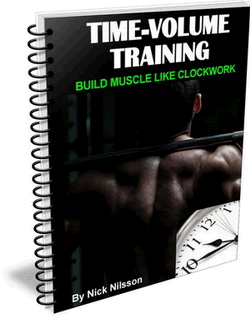The Front Squat is one of the most effective thigh and core-training exercises a person can do.
But what stops most people from doing it? The answer: holding the bar can be just plain uncomfortable.
The "Sting Ray" from Advanced Fitness, Inc., maker of the "Manta Ray" for the squat, is designed to address this problem.
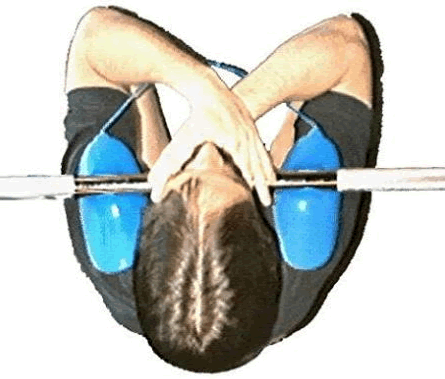
By attaching two specially-shaped polyurethane polymer forms to the bar, the Sting Ray is reported to distribute the load of the bar over a greater surface area, dramatically decreasing the uncomfortable pressure on the body during the front squat movement.
The question is, does the Sting Ray effectively achieve this goal?
To answer this question, we need to look at the mechanics and set-up of the front squat movement and how the Sting Ray is designed to work to improve the movement.
In a nutshell, a front squat is basically done exactly the same as a back squat, the major difference being that the bar is held across the front of your body rather than the back. This changes not only the balance of the movement, but also where the tension is placed on your muscles.
The front squat is generally used to more effectively target the quadriceps. Since the weight is held at the front of your body, you are able to maintain a more vertical torso position. This allows more tension to be placed on the quads rather than the glutes and lower back.
This exercise requires strong abdominals and shoulders in order to keep the barbell properly racked across the front of the shoulders ("racked" in this case means how the bar is held in place on your shoulders), but it is extremely effective in working the quadriceps.
There are two methods of holding the bar on your shoulders (racking).
The first method is the "Clean" style rack, which looks a lot like the bottom position of a barbell shoulder press but with a narrow grip and the elbows pointed directly forward.
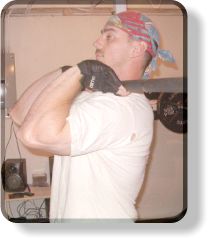
This method gives a wider "base" on the bar but is very difficult for those lacking elbow, wrist and shoulder flexibility or for anyone who has any trouble with those joints.
A trainer with large arms may have trouble with this style of rack as well, as the muscle mass will prevent the necessary range of flexibility.
The second method is the "Crossed-Arms" style rack. With this method, the bar is placed across the front shoulder muscles (anterior deltoids), the elbows are pointed straight forward, the forearms are crossed over directly in front and the hands are on the bar.
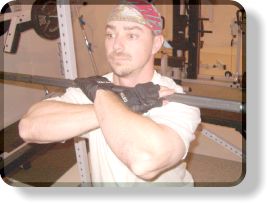
If you raise your arms out in front of you and touch your right hand to your left shoulder and your left hand to your right shoulder, you'll see how this position looks.
The crossed-arm grip is easier on the joints of the upper body but leaves you with somewhat less control over the bar. The bar also has a greater tendency to roll back down into the throat, which is never a good thing!The crossed-arm grip is easier on the joints of the upper body but leaves you with somewhat less control over the bar. The bar also has a greater tendency to roll back down into the throat, which is never a good thing!
Also, and this is a problem with both racking styles, when the bar rests directly on the collar bones, it creates pressure on the rib cage, which can cause you to run out of breath before your legs are thoroughly worked.
How The Sting Ray Works:
The Sting Ray directly addresses the problems associated with racking the bar across your shoulders.
First, it utilizes the crossed-arm style of racking in order to decrease stress on the joints of the arms while also decreasing and eliminating the problems you'll find with the crossed-arm style.
Its unique shape allows it to rest comfortably on the shoulders while spreading the load of the bar over a far greater surface area. This increased distribution of weight ensures that the bar doesn't dig into the shoulders or create unnecessary pressure on the rib cage while lifting.
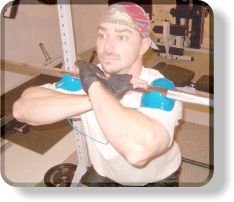
By clamping directly onto the bar, the Sting Ray also completely eliminates any chance of the bar rolling either forward and down or backward into your throat. This feature also increases the amount of control you have over the bar while doing the movement, allowing for greater stability of the bar.
Is The Sting Ray Effective For Front Squats?
The answer is "yes."
The Sting Ray accomplishes its goal of making the front squat a more comfortable and productive exercise. You'll still have to do the work but the Sting Ray will allow you to focus on working the muscles you're targeting and not on the pain of holding the bar across your shoulders. This makes it a very effective training tool.
In my own training, I've actually worked at front squats and tried to find a way to do them comfortably without much success.
The first time I used the Sting Ray, however, I found I was able to do the exercise with better form and focus on working the legs rather than on how much the bar was digging into my shoulders.
Including the front squat exercise in your leg workouts will help you to build a more balanced physique both in terms of muscle development and strength. While the back squat strongly affects the posterior muscles of your body, the front squat strongly affects the muscles on the front side of your body. Your abs will get such a great workout, you won't even need to work them directly after doing front squats.
If you work out in a home gym and don't have access to a squat rack but do have access to a bench press bench, the front squat is ideal for you.
Normally, to do the back squat, you would have to shoulder press the bar over your head and into position on your back, do your set, then lift it back up and over. This not only limits the amount of weight you can use but decreases the safety of the exercise.
With the Sting Ray, you can set your bar in your bench press racks, sit in front of it then get the bar into position for a front squat. You'll get the benefits of a squatting exercise without the inconvenience, weight limits, or safety issues of lifting the bar overhead.
The front squat is also very useful for those who have knee problems but want to work their thighs. Other exercises that focus on the quads, such as sissy squats, lunges and leg extensions, can be quite hard on the knees. The front squat is quite comfortable on the knees and should pose no problems.
The Sting Ray does have its drawbacks but they are minimal compared to its usefulness.
Since the Sting Ray comes in two separate pieces (they are attached with a connective tie), proper placement on the bar can be tricky. This is one of the drawbacks of the Manta Ray as well but having two separate pieces can make it a little harder to get right.
When using the Sting Ray, the pieces must not only be placed so that they are even on the bar from side-to-side but also rotationally (meaning that one piece can't be placed further around on the bar than the other).
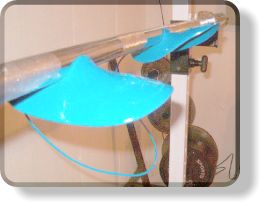
To illustrate this, hold your hands out in front then pretend like you're wringing out a towel. See how one hand is rotated down and one is rotated up? This can happen when you place the Sting Ray on the bar. This is easily remedied by eyeballing the pieces and/or setting your shoulders under it and rotating one piece until it's even with the other.
On the plus side, having the two separate pieces does allow for more adjustability with regards to body structure, i.e. a person with wider shoulders or narrower shoulders can place the Sting Ray wider out or closer in on the bar.
A good way to deal with where to set the Sting Ray is to experiment and find the proper placement for your body structure.
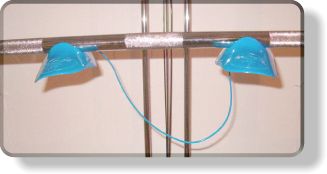
Once you've got it, use the same bar every time and note the overlap of the Sting Ray pieces over the knurled (rough) portion of the bar compared to the smooth center area. You can use finger-widths on the bar to be your guide, e.g. one finger of overlap, two fingers, etc.
Conclusion:
Is the Sting Ray a useful piece of equipment for making the Front Squat a more effective and comfortable exercise to perform? Absolutely.
Let me put it this way...if you're not doing the front squat, you should. It's an excellent exercise. And if you have trouble doing the front squat, you should use a Sting Ray.
Get your Sting Ray here
![]()
More From Fitstep.com
| You're Breathing Wrong...Here's Why... | |
| 3 Things People Do To Totally Screw Up Their Fat Loss | |
| 7 Simple Rules for What You Should Eat | |
| Squat With ZERO Back Pain With One-Arm Gripping Dumbbell Squats |
Share This Page...
---
Home -> Muscle and Strength -> Training Equipment Reviews -> Sting Ray



